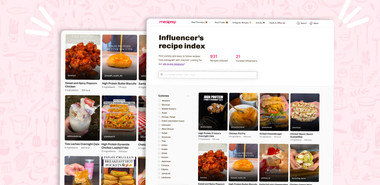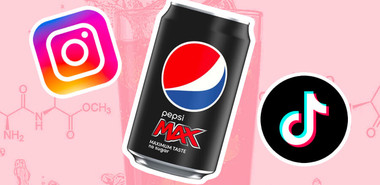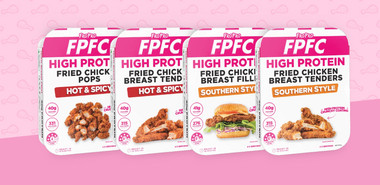| # NAME | Serving size | Sugar per 100g |
|---|---|---|
| 30g | 1g | |
| 33g | 2.9g | |
| 33g | 3.0g | |
| 35g | 5.5g | |
| 45g | 8.7g | |
| 45g | 2.9g |
Breakfast cereal is a pantry staple in most Australian family households. As a nutritionist, parents regularly ask which is the healthiest breakfast cereal for their children to enjoy.
The thing is: marketers are extremely clever in convincing parents their cereal is a nutritious option. But most cereal marketed towards children will have very little nutritional benefit and searching for a nourishing option can be overwhelming.
So, here’s my list of the top 6 healthy kids cereal options (and 6 of the worst!)
6 Healthy Cereals for Kids ✅
Let’s be clear: the healthiest cereal for kids is one that you make at home using whole food ingredients such as oats, buckwheat, nuts, seeds, coconut flakes and flavours like cinnamon, cacao and vanilla.
But, we don’t all have time for that. The list below is based on sugar and fibre content, as well as the ingredient quality.
Woolworths Rolled Traditional Oats
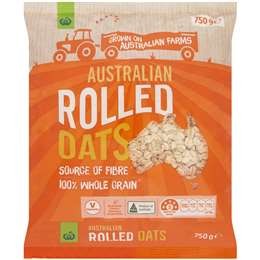
Serving size: 30g
Sugar per 100g: 1g
Fibre per 100g: 10.8g
Sodium per 100g: <5mg
Ingredients: Whole Grain Oats (100%)
Rolled Oats are a highly nutritious, affordable and versatile pantry staple. They’re low in sugar and sodium, but a good source of fibre and protein.
Use them as a nourishing porridge, make overnight oats, combine it with nuts and fruit for muesli or toast it for crunchy granola. If your child isn’t big on cereal, rolled oats can be used for breakfast muffins, nutritious slices, bulking out smoothies or even for pancakes.
Stick to rolled or steel-cut oats and avoid quick oats as these will have much less fibre. Flavoured sachets are also not recommended as these tend to have sugar and unnatural flavours added.
Sanitarium Weet-bix Little Kids
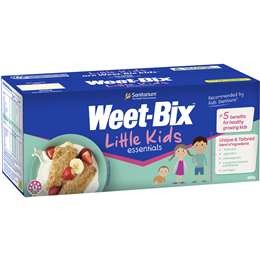
Serving size: 33g
Sugar per 100g: 2.9g
Fibre per 100g: 12.4g
Sodium per 100g: 12mg
Ingredients: Wholegrain cereals (97%) [wheat (77%), rye (10%), sorghum (10%)], raw sugar, calcium rich seaweed, barley malt extract, minerals (iron, zinc), vitamins (B3, B2, B6, B1, folate).
Sanitarium Weet-bix Little Kids are an alternative to the original Weet-bix with less sodium. They virtually have the same in the way of sugar and ingredients. If you haven’t discovered them yet and are interested in switching, I highly doubt your child will even notice the change!
One negative of the Weet-bix Little Kids is that they are only available in a small box and are more expensive which may not be suitable for your family.
Sanitarium Weet-bix Breakfast Cereal
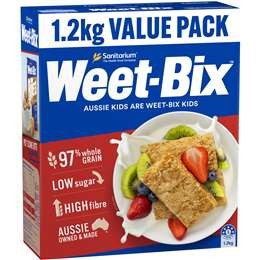
Serving size: 33g
Sugar per 100g: 3.0g
Fibre per 100g: 12.9g
Sodium per 100g: 270mg
Ingredients: Wholegrain wheat(97%), raw sugar, salt, barley malt extract, vitamins (niacin, thiamin, riboflavin, folate), mineral (iron).
Sanitarium Weet-bix is a breakfast cereal that is a pantry staple in my household as it’s low sugar, high in fibre and the kids love it. It’s also such an easy one to make in the morning and can be nutrient boosted with Greek yoghurt, fresh fruit or a crunchy topping of nuts and seeds.
Due to the higher sodium and addition of raw sugar and barley malt extract, it’s not a product I recommend every day but can be part of a healthy diet.
Freedom Foods Rice Puffs
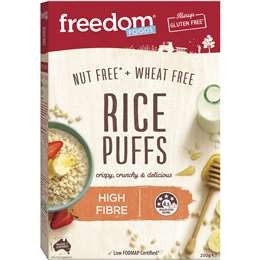
Serving size: 35g
Sugar per 100g: 5.5g
Fibre per 100g: 11.5g
Sodium per 100g: 250mg
Ingredients: Rice Flour (79%), Resistant Dextrin, Sugar, Salt, Emulsifier (Sunflower Lecithin).
Much lower in sodium and sugar, Freedom Rice Puffs are a better alternative than traditional Rice Bubbles. The addition of the prebiotic fibre, Resistant Dextrin, adds a good source of fibre for your child’s gut bacteria. Although keep in mind, sugar is not great for our gut health.
If you’re wanting to transition your child from Kellogg’s Rice Bubbles, just add a small amount of rice puffs and increase it over time until you have no Kellogg’s bubbles left.
Be Natural Mini Bites
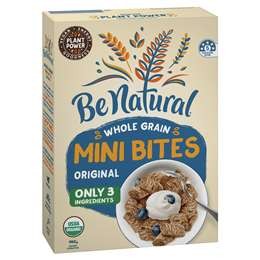
Serving size: 45g
Sugar per 100g: 8.7g
Fibre per 100g: 11.9g
Sodium per 100g: 5mg
Ingredients: Organic whole grain wheat (88%), organic demerara sugar, natural flavour.
With only 3 ingredients, these Be Natural Mini Bites are a good addition for kids with a sweet tooth. The Demerara sugar adds to the sweetness but still keeps it much lower than a lot of the kid’s cereals on the market.
As they are crunchy and sweet, these might be a good vehicle to transition your kids over to a lower-sugar option like Weet-bix or Oats. Kids also love nibbling on these as a snack so they could be an alternative to sugar-loaded cookies.
Jordans Granola Low Sugar Almond Hazelnut
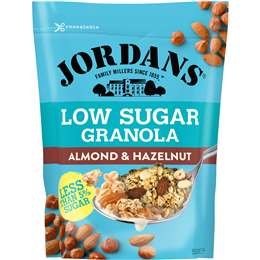
Serving size: 45g
Sugar per 100g: 2.9g
Fibre per 100g: 7.9g
Sodium per 100g: 10mg
Ingredients: Whole Grain Oat Flakes (55%), Barley Flakes (19%), Chicory Root Fibre (11%), Nuts (7%) (Sliced & Whole Almonds (5%), Chopped Roasted Hazelnuts (2%)), Sunflower Oil, Seeds (1%) (Pumpkin Seeds, Sunflower Seeds), Desiccated Coconut, Natural Flavouring.
Jordans Granola Low Sugar Almond Hazelnut is not marketed as a kid’s cereal but it is delicious and crunchy that it may foul your children into thinking it’s a kid-approved product. You can also use it as a nutritious topping for Greek yoghurt, chia pudding or pancakes!
Aside from the use of natural flavouring and sunflower oil, this product offers great nutrient variety, is low in sugar and only contains 10mg of sodium.
It is more expensive than many of the big-name cereals which may prove cost-prohibitive for some families.
There are healthier cereals on the marketed that aren’t directly targeting kids which may be a good option for your family. Read: 6 Healthy Breakfast Cereal Options for Adults
- Don’t be fooled by the marketing jargon on the front of the pack and take the time read the ingredients lists and nutrition panel.
- Look for quality, whole food ingredients.
- Compare the nutrients by 100g not by the serve.
- Choose a cereal with 8g of sugar per 100g or less.
- Look for cereals with 8g or more of fibre per 100g.
- Opt for a cereal that has about 250mg or less of sodium per 100g.
What Makes Cereal Healthy for Kids? 👦🏻
There are several key factors I look at to determine whether cereal is a healthy option for my child or should remain on the shelves.
They’re not too dissimilar to what I look at when assessing the nutritional value of an adult’s cereal.
- The number and quality of ingredients
- The sugar content
- The fibre content
- The protein content
- The sodium content
What to Look For When Shopping for Healthy Kids Cereal 🛒
1. Read the Nutrition Panel
The first thing to do when looking for a healthy kids cereal, or any food product for that matter, is to flip it over to the nutrient panel and ingredients list.
Cereal manufacturers work especially hard to make their product look the loudest and draw the attention of your kids. They also are very clever at marketing to the parents with comments such as “no sugar”, “no additives” and one of my favourites: “to help nourish kids’ minds”.
Please, before you consider any packaged food product, flip it over and look at the back.
2. Review the QUALITY of Ingredients
The ingredients list can be daunting but there are a few simple rules I follow:
- If there are more than 15 ingredients of varying quality, consider another product.
- If you can’t pronounce the names of ingredients or there are lots of numbers it’s highly processed.
- If there are lots of ingredients and sugar is listed in the first two, it may be more an occasional treat than a breakfast item.
- If you can’t see any whole grains listed like oats or barley, the cereal is most likely to be refined carbohydrate based and of a low fibre content.
3. Check the Sugar Content
Kids cereals are the biggest offenders in the sugar department with some over 40% sugar. That means, for each bowl of cereal your child is eating, almost half is sugar!
Sugar is also one of the most well-hidden products with over 56 different names for the ingredient. Anything ending in “ose” such as glucose or sucrose is sugar. Ingredients featuring syrup is also a form of sugar.
There are 56 different names for sugar including dextrose, glucose, high-fructose corn syrup and rice malt syrup.
The sugar content will be listed under ‘carbohydrates’ on the nutrition information panel. Most brands will highlight the “per serving” list, but I encourage you to look at the per 100g.
It’s not often you measure out the exact serve of cereal and some children will eat more than the recommended serving size.
Referring to the “per 100g” numbers will also allow you to easily compare with other cereal products.
Choose a cereal that has 8g of sugar or less per 100g. Anything more and you’re child will be enjoying a dessert for breakfast!
4. The Fibre Content
Most children don’t get enough fibre in their daily diet but cereal can be an easy way to increase their intake.
Children need a minimum of 18-28g of fibre a day (depending on their age) to keep their digestive system healthy.
A cereal made with whole grains will have a higher fibre content than a refined grain product. Other ingredients such as seeds, chickpea fibre or psyllium husks will also increase the fibre content.
Choose a cereal that has about 8g of dietary fibre (or more) per 100g.
5. The Protein Content
Protein isn’t my first focus when choosing the healthiest breakfast cereal for kids but it is one to keep in mind. This is particularly the case for vegetarians, fussy eaters or those with high nutrient demands.
Protein is vital for your child’s growth and development but also will help with blood sugar balance and energy maintenance. It will also help keep your kids feeling fuller for longer.
Adding protein toppings to your child’s cereal is beneficial. Think cow’s milk (if tolerated), nut milk, nuts, nut butter, seeds or a child-friendly protein powder.
Increase the nutrient content of your child’s cereal with your toppings such as yoghurt, milk, nuts and seeds.
6. The Sodium Content
If your child eats processed and packaged foods regularly, chances are they’re consuming too much sodium (AKA salt).
Breakfast cereals, even the sweet ones, are a surprising source of sodium!
For children, I recommend you look for a cereal with less than 250mg of sodium per 100g. Babies and young toddlers should not be consuming any products with added sodium.
Are Fortified Cereals Healthier for Kids? 🤔
Fortified cereals have extra vitamins and minerals added, like B vitamins and iron. This was done to fix nutrient shortages. But these cereals can be highly processed, which means they might lack natural nutrients.
Also, too much of these added nutrients isn’t always good, especially for kids under 10. It’s important not to rely only on these cereals for your child’s nutrition.
When picking cereals, check for added sugar, refined grains, sodium, and trans fats, not just the vitamins and minerals. Just because a cereal is fortified, doesn’t automatically make it the best choice.
Should I Choose Cereal with a High Health Star Rating? ⭐️
The short answer is no.
Don’t base your cereal selection on the health star rating as there are obvious flaws in the program.
The health star rating was designed to guide people on healthier food products. It’s a voluntary program with only about 20% of packaged foods having a health star rating. For many smaller brands, it’s too expensive and there are too many hoops to go through to be involved.
One of the main concerns with the program is that it is compensatory. This means a negative element of the product can be resolved by a positive attribute.
A great example of this was when Milo was first given a 4.5-star rating even though it is high in sugar. Sultana Bran is another product that is nearly 30% sugar, yet has a 4.5-star rating.
The health star rating is just another marketing tool food brands are using to encourage you to buy their packaged foods. Notice whole food fresh products like bananas and chicken don’t have a health star rating?
Read the nutrition information and ingredients list or better yet, use whole foods to make your own cereal.
The Worst Cereals for Kids 👎🏻
The list of the worst cereals for kids could be lengthy. It’s not hard to find cereal loaded with sugar, sodium, flavours and lacking in anything nutritious on the supermarket shelves.
Here, I list my top 5 worst cereals for kids based mainly on sugar, fibre and sodium content. It’s fair to say, Kellogg’s take the crown of producing some very nutrient-poor food products targeted towards kids.
-
Kellogg’s Frosties 41.3% sugar
-
Kellogg’s Froot Loops 38% sugar
-
Kellogg’s Coco Pops Chex 37.4% sugar
-
Kellogg’s Coco Pops 36.5% sugar
-
Lowan Cocoa Bombs 29.8% sugar
How to Get Your Kids to Eat Healthy Cereal 😎
Are you a parent of a fussy eater? Some kids are very particular about the type and brand of food they eat. Moving your child away from Coco Pops to a bowl of oats can seem impossible and in many cases, it might be a long process.
Here are my top tips when transitioning your child to a healthier cereal:
- Do it slowly with no pressure.
- Try a better verison of your current cereal. For example, switch from Coco Pops to Freedom Foods Messy Monkeys.
- Mix a small portion (1tbsp – 1/4 cup) of the new cereal in with the old. Gradualy increase it over time.
- Play with making your own cereal with the kids such as rice bubbles. Start with making an exactly replica (sugar and all) and then adjust the recipe slowly to improve the nutrient balance.
- Experiment with toppings to ehance the nutrient content.
- Alternate cereal with another breakfast offering such as eggs, pancakes, toast or a smoothie.
Healthy Kids Cereal FAQs
Is Weet-bix actually healthy?
Is Milo cereal healthy for toddlers?
I wouldn’t recommend Milo cereal for toddlers. Milo cereal, like many commercial cereals, is extremely high in added sugars. Not to mention it’s low in fibre, and high sodium, which are also not good for toddlers (or any kids/adults).
What is the best age to start cereal?
Solid foods like cereal are typically introduced when a baby is around 6 months old, but it’s best to consult a pediatrician as individual needs may vary. Starting with single-grain cereals, like rice cereal, is common due to the low risk of allergies.
Cereal can be a nutritious way for kids to start their day especially if you steer clear of the sugar-loaded and flavoured cereals.
If you can, making your own cereal is the best option or offering it to your children in moderation rather than an everyday meal.
If you are searching for the healthiest breakfast cereal for kids, keep these key things in mind.







